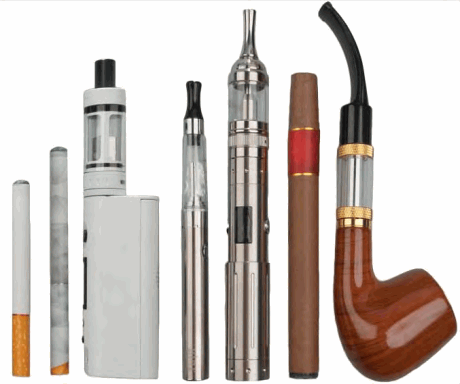A group of researchers from China and Canada have investigated the arsenic species in e-liquids used for e-cigarettes and the aerosols generated from them. Besides arsenate, arsenite and monomethylarsonic acid also three new species were detected.
Background:Electronic cigarettes (e-cigarettes) are used by an increasing number of consumers since their introduction into the market in 2004, having reached about 16 % among high school students in 2015. Although different brands vary widely in design and appearance, they generally function similarly: a solution known as e-liquid is vaporized by a battery-driven heating component and the generated aerosol is inhaled via a mouthpiece by the puffing consumer.

Photo: Different types of e-cigarettes including a disposable e-cigarette, a rechargeable e-cigarette, a
medium-size tank device, large-size tank devices, an e-cigar, and an
e-pipe.
E-liquids typically uses propylene glycol and/or glycerine as a solvent to dissolve flavouring chemicals, nicotine and other additives. Because these ingredients are simpler than the mixture of chemicals generated by burning tobacco, e-cigarettes have been regarded as a less harmful alternative to tobacco smoking. However, numerous studies during the last years have found many health risks of e-cigarettes, including fine and ultrafine particles, volatile organic compounds (VOCs), endotoxins and toxic metals. Also, several studies have found the presence of arsenic in the e-liquids or the generated aerosol. Since the toxicity of arsenic depends very strongly on the species being present, the total concentration being reported is not a good enough information for evaluating the health risk.
The new study:The aim of the new study was to determine the concentration of the arsenic species being present in e-liquids and the aerosols generated from them. A representative selection of seventeen most consumed e-liquids were purchased from suppliers in China and Canada. Aerosol samples were generated by vaping e-liquid samples using the tank-type e-cigarette devices. The condensed aerosol was collected then for subsequent arsenic speciation analysis.
Arsenic speciation analysis was performed by using high-performance liquid chromatography interfaced to inductively coupled plasma mass spectrometry (HPLC-ICP-MS). Arsenic species were separated by a strong anion-exchange column operated under gradient elution mode. For quality control, the certified reference material CRM No.18 Human Urine was analysed in parallel with samples.
The collision cell of the ICP-MS was flushed with He to suppress potential polyatomic interferences caused by ArCl+. The amount of arsenic species being determined was about 89% +- 14 % of the total arsenic found by direct ICP-MS determination. Using this methodology, six arsenic species could be determined in the e-liquids, including arsenate, arsenite, monomethylarsonic acid and three new species not reported previously. The same six arsenic species could also be detected in the aerosol samples, however with different distribution. The concentration of arsenite in the aerosol was significantly higher than in the original e-liquid. The results of an estimation indicated that e-cigarette smokers could inhale inorganic arsenic species at an inhalation concentration nearly half of the permissible exposure limit (10 µg/m3) set by OSHA for the workplace. The researchers concluded that the health risk of e-cigarette use with respect to lung cancer might be serious, calling for further research and regulatory considerations.
 The original publication:
The original publication:

Qing-qing Liu, Cheng-zhi Huang,
X. Chris Le,
Arsenic species in electronic cigarettes: Determination and potential health risk, J. Environ. Sci., 91 (2020) 168-176.
DOI: 10.1016/j.jes.2020.01.023
 Related studies
Related studies
Wen-chan Deng, Jordan R.M. Schofield,
X. Chris Le, Xing-Fang Li.
Electronic cigarettes and toxic substances, including arsenic species, J. Environ. Sci., 92 (2020) 278-283.
DOI: 10.1016/j.jes.2020.03.004
Di Zhao, Ana Navas-Acien, Vesna Ilievski, Vesna Slakovich, Pablo Olmedo, Bernat Adria-Mora, Arce Domingo-Relloso, Angela Aherrera, Norman J. Kleiman, Ana M. Rule, Markus Hilpert,
Metal concentrations in electronic cigarette aerosol: Effect of open-system and closed-system devices and power settings, Environ. Res., 174 (2019) 125-134.
DOI: 10.1016/j.envres.2019.04.003

E. Kamilari, K. Farsalinos, K. Poulas, C.G. Kontoyannis, M.G. Orkoula,
Detection and quantitative determination of heavy metals in electronic cigarette refill liquids using Total Reflection X-ray Fluorescence Spectrometry, Food Chem. Toxicol., 116 (2018) 233-237.
DOI: 10.1016/j.fct.2018.04.035.

Vinit K. Mishra, Ki-Hyun Kim, Pallabi Samaddar, Sandeep Kumar, M. L. Aggarwal, K. M. Chacko,
Review on metallic components released due to the use of electronic cigarettes, Environ. Eng. Res., 22/2 (2017) 131-140.
DOI: 10.4491/eer.2017.056

Dominic L. Palazzolo, Andrew P. Crow, John M. Nelson, Robert A. Johnson,
Trace Metals Derived from Electronic Cigarette (ECIG) Generated Aerosol: Potential Problem of ECIG Devices That Contain Nickel, Front. Physiol., 7 (2017) 663.
DOI: 10.3389/fphys.2016.00663

M. Williams, K. Bozhilov, S. Ghai, P. Talbot,
Elements including metals in the atomizer and aerosol of disposable electronic cigarettes and electronic hookahs. PLoS ONE, 12/4 (2017) e0175430.
DOI: 10.1371/journal.pone.0175430
Vladimir B. Mikheev, Marielle C. Brinkman, Courtney A. Granville, Sydney M. Gordon, Pamela I. Clark,
Real-Time Measurement of Electronic Cigarette Aerosol Size Distribution and Metals Content Analysis, Nicotine Tob. Res., 18/9 (2016) 1895–1902.
DOI: 10.1093/ntr/ntw128

N. Beauval, M. Howsam, S. Antherieu, D. Allorge, M. Soyez, G. Garçon, J.F. Goossens, J.M. Lo-Guidice, A. Garat,
Trace elements in e-liquids - Development and validation of an ICPMS method for the analysis of electronic cigarette refills, Regul. Toxicol. Pharmacol., 79 (2016) 144-148.
DOI: 10.1016/j.yrtph.2016.03.024
M.L. Goniewicz, J. Knysak, M. Gawron, L. Kosmider, A. Sobczak, J.
Kurek, A. Prokopowicz, M. Jablonska-Czapla, C. Rosik-Dulewska, C.
Havel, P. Jacob, N. Benowitz,
Levels of selected carcinogens and
toxicants in vapor from electronic cigarettes, Tob. Control., 23/2
(2014) 133–139.
DOI: 10.1136/tobaccocontrol-2012-050859
 Related EVISA Resources
Related EVISA Resources Brief summary: ICP-MS - A versatile detection system for speciation analysis
Brief summary: ICP-MS - A versatile detection system for speciation analysis  Brief summary: LC-ICP-MS - The most often used hyphenated system for speciation analysis
Brief summary: LC-ICP-MS - The most often used hyphenated system for speciation analysis
 Related EVISA News
Related EVISA News
last time modified: January 12, 2025